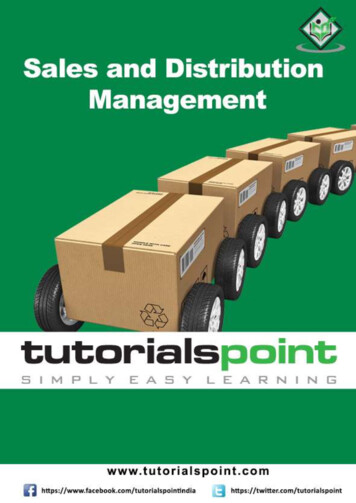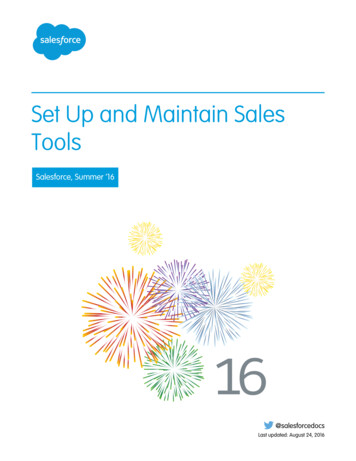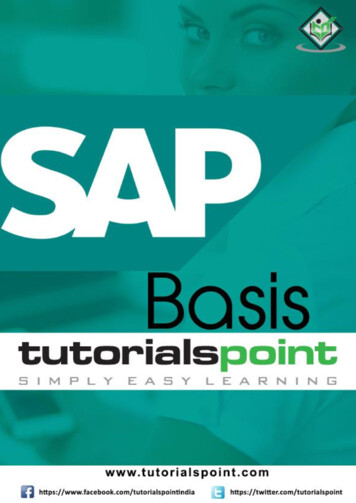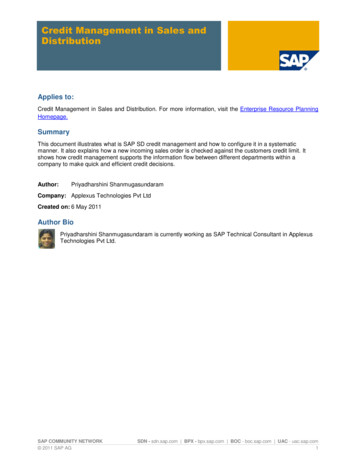
Transcription
Sales and Distribution Management
Sales and Distribution ManagementAbout the TutorialSales management is an art where the sales executive or the salesperson helps theorganization or individual to achieve its objective or buy a product with their skills.This is a brief introductory tutorial that explains the functions in sales and distributionmanagement. This tutorial also throws light on the strategies applied in distributing tasksto the sales personnel and their performance.AudienceThis tutorial will be useful for those who wish to understand sales and distributionmanagement as an art to increase customer demand for a particular product. Thistutorial will help those who wish to apply sales techniques and manage a firm’s salesoperation.PrerequisitesTo understand this tutorial, it is advisable to have a foundation level knowledge ofmanagement. However, general students who wish to get a brief overview of sales anddistribution management may find this tutorial quite useful.Disclaimer & Copyright Copyright 2016 by Tutorials Point (I) Pvt. Ltd.All the content and graphics published in this e-book are the property of Tutorials Point(I) Pvt. Ltd. The user of this e-book is prohibited to reuse, retain, copy, distribute orrepublish any contents or a part of contents of this e-book in any manner without writtenconsent of the publisher.We strive to update the contents of our website and tutorials as timely and as preciselyas possible, however, the contents may contain inaccuracies or errors. Tutorials Point (I)Pvt. Ltd. provides no guarantee regarding the accuracy, timeliness or completeness ofour website or its contents including this tutorial. If you discover any errors on ourwebsite or in this tutorial, please notify us at contact@tutorialspoint.com.i
Sales and Distribution ManagementTable of ContentsAbout the Tutorial . iAudience . iPrerequisites . iDisclaimer & Copyright . iTable of Contents . ii1.SDM — INTRODUCTION . 1Skills of a Sales Executive. 2Importance of Sales Management . 3Objective of Sales Management . 42.SDM — SALES MANAGEMENT STEPS . 5Set Objective . 5Develop Sales Strategy . 5Develop Tactics. 63.SDM — PROCESS . 7Planning . 7Staffing . 8Training . 9Leading . 9Controlling . 10Performance . 124.SDM — SALES METHODS . 13Electronic Sales . 16Request for Proposal . 17ii
Sales and Distribution Management5.SDM — TECHNIQUES OF SALES. 18Conceptual Selling . 18Sales Negotiation . 19Sales Negotiation Strategies . 20Negotiation Outcomes . 20Reverse Selling . 21Take away . 22Sales Outsourcing . 22Advantages of Sales Outsourcing . 236.SDM — SALES ORGANIZATION . 24Characteristics of a Sales Organization . 24Significance of Sales Organization . 25Types of Sales Organization . 25Functional Type . 26Product Type . 27Consumer Specialization Type . 28Area Type . 307.SDM — SALES QUOTA . 32Objectives. 32Types of Sales Quota . 32Methods for Setting Sales Quota . 338.SDM — SALES TERRITORY . 35Reasons for Establishing Territories . 35Procedure for Designing . 37iii
Sales and Distribution ManagementSelect Control Point . 37Making an Account Analysis . 38Developing a Salesperson Workload Analysis . 38Combining Geographical Control Units into Sales Territories. 39Territory Shape . 39Assigning Sales Personnel to Territories . 409.SDM — PERSONAL SELLING . 41Objectives of Personal Selling . 41Relevant Situation for Personal Selling . 42Diversity of Selling Situation . 4310.SDM — STEPS IN PERSONAL SELLING. 46Prospecting. 46Train/Educate the Prospects. 47Preparation for the Sale of Product . 47Presentation . 48Handling Objections . 49Closing the Sale . 50Follow-up . 5111.SDM — SALES MANAGEMENT BUDGET . 52Objective of Sales Budgeting . 52Methods of Sales Budgeting . 52Preparation of Sales Budget . 53Communicating Overall Objectives . 54Selling the Sales Budget to Top Management . 54iv
Sales and Distribution Management12.SDM — MARKETING CHANNEL . 55Wholesale . 55Retail . 56v
1. SDM — IntroductionSales and Distribution ManagementSales refers to the exchange of goods/ commodities against money or service. It is theonly revenue generating function in an organization. It has formed an important part inbusiness throughout history. Even prior to the introduction of money, people used toexchange goods in order to fulfill the needs, which is known as the barter system.Example of Barter SystemA has 100 kg of rice and B has 50 kg of wheat. Here, A needs wheat and B needs rice.They agree to exchange 50 kg of rice and 25 kg of wheat upon mutual understanding.Conditions of Sales There are two parties involved in the transaction, the seller and the buyer. The seller is the provider of goods or services and the buyer is the purchaser inexchange of money.The seller of goods has to transfer the title of ownership of the item to the buyer uponan agreed price. A person who sells goods or services on behalf of the seller is known asthe salesman/woman.Distribution is the process of making a product or service available for use orconsumption to the end consumer or business.Distribution could be of the following two types:Direct DistributionIt can be defined as expanding or moving from one place to another without changingdirection or stopping. For example, Bata has no distribution channel; it sells its productsdirectly to the end consumers.Indirect DistributionIt can be defined as means that are not directly caused by or resulting from something.For example, LG sells its product from the factory to the dealers, and it reaches theconsumers through dealers.The following image shows the end-products stored at a warehouse, ready for shipmentto the dealers/consumers.1
Sales and Distribution ManagementSales management in an organization is a business discipline, which focuses on thepractical application of sales techniques and the management of a firm’s sales operation.It is done in an efficient and effective manner through planning, staffing, training,leading and controlling organizational resources. Sales management is done by SalesManagers and they are responsible for generating sales, profits and customersatisfaction.Skills of a Sales ExecutiveSales management is an art where the sales executive or the salesperson helps theorganization or individual to achieve its objective or buy a product with their skills.The following are some skills that a sales executive needs to possess:Conceptual SkillsConceptual skill includes the formulation of ideas. Managers understand abstractrelationships, improve ideas, and solve issues creatively. The sales executive should bewell versed with the concept of the product he/she is selling.People SkillsPeople skills involve the ability to interact effectively with people in a friendly way,especially in business. The term ‘people skills’ involves both psychological skills andsocial skills, but they are less inclusive than life skills.Every person has a different mindset, so a sales executive should know how to presentthe product depending on the customer’s mindset.Technical Skills2
Sales and Distribution ManagementTechnical skills are the abilities captured through learning and practice. They are oftenjob or task specific. In simple words, a specific skill set or proficiency is required toperform a specific job or task. As a part of conceptual skills, a sales executive shouldalso have a good grasp on the technical skills of the product.Decision SkillsDecision skills are the most important because to tackle the questions from consumers,sales executive should always have the knowledge of competitors’ products and take awise decision.Monitoring PerformanceSales executives should monitor the performance of the employees and report to highermanagement to improve the performance and fill the loop holes.Thus, conceptual skills deal with ideas, technical skills deal with things, people skillsconcern individuals, technical skills are concerned with product-specific skills, anddecision skills relate to decision-making.Importance of Sales ManagementSales management is very crucial for any organization to achieve its targets. In order toincrease customer demand for a particular product, we need management of sales.The following points need to be considered for sales management in an organization: The first and foremost importance of sales management is that it facilitates thesale of a product at a price, which realizes profits and helps in generating revenueto the company. It helps to achieve organizational goals and objectives by focusing on the aim andplanning a strategy regarding achievement of the goal within a timeframe. Sales team monitors the customer preference, government policy, competitorsituation, etc., to make the required changes accordingly and manage sales. By monitoring the customer preference, the salesperson develops a positiverelationship with the customer, which helps to retain the customer for a longperiod of time. Both the buyers and sellers have the same type of relationship, which is based onexchange of goods, services and money. This helps in attaining customersatisfaction.Sales Management may differ from one organization to the other, but overall, we canconclude that sales management is very important for an organization for achieving itsshort- and long-term goals.3
Sales and Distribution ManagementObjective of Sales ManagementEvery organization has an objective before initializing functions. We need to understandthe goal of managing sales. Here we are discussing Sales Management in terms of itsobjectives.Sales VolumeIt is the capacity or the number of items sold or services sold in the normal operations ofa company in a specified period. The foremost objective of sales management is toincrease sales volume to generate revenue.Contribution to ProfitThe sales of the organization should contribute to profit, as it is the only revenuegenerating department. It can be calculated as the percentage or ratio of gain in totalturnover.Continuing GrowthOne of the main objectives of Sales Management is to retain consumers to continuegrowth of the organization. There should be regular expansion of sales and demand foran item in the market with new advanced formulation.These are the major objectives a sales executive has to focus on in sales management.4
2. SDM — Sales Management StepsSales and Distribution ManagementCompanies use sales strategies and tactics in order to make a consumer buy theirproducts or services. Before we processed further, we should know the meaning of salesstrategies and tactics. Although they go hand in hand, they are distinct.Set ObjectiveThe very first step in sales management is setting goals and objectives. The seniormanagement of a firm needs to sit together and reach a mutual decision regarding whatthe vision and resolution of the firm is.This may sound quite easy but setting objective acts as a framework for designing acompany. If efficient decisions are made and objectives are set according to thecompany’s potential and the market demand, the company progresses wonderfully.However, if the objectives are poorly set, then the company might not prosper.Develop Sales StrategyAfter the objectives are set for the company to achieve, a strategy needs to be designed.Sales strategy can be defined as how a company markets or wants to sell its products orservices. It can be a concept of how the company meets the desired objectives andmarketing goals; it also clarifies what the sales executives do.Strategy includes various components. following are a few of the components:5
Sales and Distribution Management Knowledge of the company’s brand history and consumer market The way marketing is going to influence overall business Competitors’ performance Pros and cons of the planDevelop TacticsA strategy explains the purpose of the company whereas tactics explain the process tomove forward and implement the plan. Sales strategy is important as compared to theindividual tactics. But after the strategy is designed, we need to develop tactics to followthe strategy.Sales tactics can be defined as the action taken by the company to impose its salesstrategy to bring it to life. There are different modes in which the company delivers themessage to the consumers such as websites, brochures, advertisements in social media,etc.An investor or lender will invest in the company if they know about the objective and thestrategy of the company; else, it becomes difficult for the company and the lenders tomake or justify a decision of whether to invest in the company.The company has to know that investment by lenders is very much required for themarketing campaign. If the tactics are excellent but the strategies are not defined in aproper manner or defined poorly, it does not help the company to grow.6
3. SDM — ProcessSales and Distribution ManagementSales management in an organization is a business discipline, which focuses on thepractical application of sales techniques and the management of a firm’s sales operation.It is done in an efficient and effective manner through planning, staffing, training,leading and controlling organizational resources. Now we will explain each of theseprocesses.PlanningPlanning can be defined as the process of decision-making in a systematic mannerregarding the goals and the objectives of an organization. In short, it is a process anindividual or group will undertake in the future and the resources required for attainingthem.Sales planning includes strategy, setting profit-based sales targets, quotas, salesforecasting, demand management and the screening, writing and execution of a salesplan.A sales plan is a strategic document that outlines the business targets, resources andsales activities. It basically follows the lead of the marketing plan, the strategic plan and7
Sales and Distribution Managementthe business plan with more precise detailing on how the goals and objectives can beachieved through the actual sale of products and services.StaffingStaffing is the process of capturing, deploying, and retaining a workforce of optimalquantity and quality to create a positive impact on the firm’s effectiveness.Staffing consists of the following three components: Acquisition: It involves human resource planning to select what the organizationrequires in terms of the numbers of employees needed and their attributes suchas knowledge, skills and abilities, in order to effectively meet job requirements. Deployment: It includes decisions regarding how those recruited will be assignedto specific roles according to the business demands. It also concerns the frequentappointment to more advanced jobs through internal recruitment, promotion orreorganization. Retention: It is concerned with the management of the outflow of employeesfrom an organization. It combines both managing voluntary practices likeresignation and controlling involuntary measures whereby employees are handledout of the organization through redundancy programs or other types of dismissal.Staffing is basically used in the sphere of employment. It is applicable to more than oneaspect of the working surrounding. Staffing is also used in a specific sense to refer to themanagement of employee schedules.8
Sales and Distribution ManagementTrainingThe training program in sales management provides frontline sales managers withproven skills, knowledge and tools they need to drive margin line performance.This in-depth program involves self-assessments and covers the following four crucialsales management abilities: Managing sales performance Sales coaching Recruiting Selecting sales "STARs" Sales leadershipAfter the sales personnel are recruited, the company ensures the training, i.e., off thejob and on job training related to the skills, knowledge and job culture, which helps tomeet the selling performance and goals.LeadingLeading is done by the person who possesses the leadership quality, the ability tomotivate other people and get the work done. Leading is an effective sales managementforce that invites the sales management executive to use practical tools and cuttingedge concepts to create an effective sales management model.9
Sales and Distribution ManagementThis model is derived after a thorough research and consulting experience throughcases, group discussions, problem-solving exercises, computer-aided workshops, andcommunicative case presentations.The managers need to explore various perspectives on what does and does not work,and why. A leader also monitors the work and explains the pro and cons as well as theways to complete a task effectively and efficiently.ControllingThe task assigned to the sales personnel is monitored to find out whether theorganization is achieving its target or the goals as per the planning. Controlling is aprocess, which defines the scope of and leads the actual performance against theplanned goals of the organization.Controlling dwells in verifying whether everything happens in conformity with theplans adopted, instructions issued and principles authorized. Controlling assures thatthere is effective and efficient utilization of organizational resources so as to achieve theplanned goals and objectives.Controlling judges the deviation of actual performance from the standardperformance, notices the causes of such deviations and helps in taking correctiveactions.The following figure depicts sales management with its functions and explains therole of each function. All the roles are inter-related. An individual function cannot relateto work without the help from other.10
Sales and Distribution ManagementResourcesResources are one of the important parts of sales management, as, without resources,the planned process cannot be implemented. Resources include the following:Human ResourceHuman resources can be defined as that section of a business or organization that dealswith the hiring, administration, and training of staff. In sales management, we can say itis the salesperson responsible for selling/marketing of products or services.Financial ResourceFinancial resource is the capital available to a business for investing in the form of cash,liquid securities and credit lines. Before going into business, a businessman needs tosecure sufficient financial resources.This is required in order to be able to function efficiently and sufficiently well to promotesuccess. It includes the finance that the company needs to perform the activities likecampaign, advertisement etc.MaterialsThey are assets in the form of material possessions. Here, by assets, we mean anythingof material value or usefulness that is owned by an individual or a company. It includesthe source from where the raw material could be procured in low cost.TechnologyIt is the application of science, especially to industrial or commercial goals andobjectives. it also includes the scientific technique and material used to achieve a11
Sales and Distribution Managementcommercial or industrial objective as well as the machinery and the techniques that theorganization uses for the end product.It will now be clear why resources are important in managing sales.PerformancePerformance is the completion of a given task measured against known preset standardsof accuracy, completeness, cost, and speed. In a contract, performance is assumed to bethe fulfillment of accountability in a manner that releases the performer from allliabilities under the contract.The last function is to review the performance. In this function, the leader reviews thepast performance and advises the Sales Personnel regarding the improvements required.It also involves checking that all the functions are working in a proper way and there isno deviation in achieving the goals.12
4. SDM — Sales MethodsSales and Distribution ManagementSales method can be explained as one of several techniques used to recognize revenuespecifically when revenue and expense are recognized at the time of cash collectionrather than at the time of sale.Thus, we can say that Sales Methods are the different ways to sell the product orservice. The Sales Personnel help to sell the end products to the consumer. Some salesmethods are given below.Direct SalesDirect sale is the sale of good/services involving person contact. It can be defined as themost important method that is used, as most of the consumers prefer to purchase goodsthrough a direct contact with the seller, during which they understand the features andget to know about the needs and benefits.The above illustration depicts the seller in the middle as A. Buyers are seen reaching outto the seller. It is an example of direct sales where the buyers (in green) areapproaching the seller in orange.Example: Boeing airlines sells it air buses directly to the consumer with no intermediaryinvolved.Pro forma SalesThe term pro forma is a Latin word, which means, "as a matter of form" or "for thesake of form". It is commonly used to describe a practice or document that is providedas a courtesy and that satisfies limited requirements, conforms to a norm or doctrine,tends to be performed perfunctorily and/or is considered a formality.13
Sales and Distribution ManagementPro forma financial statements are fashioned to reflect a proposed change, like a mergeror acquisition or to emphasize certain figures when a company issues an earningsannouncement to the public.It can be termed as the practice or document that is provided as a
Sales management in an organization is a business discipline, which focuses on the practical application of sales techniques and the management of a firm’s sales operation. It is done in an efficient and effective manner through planning, staffing, traini










